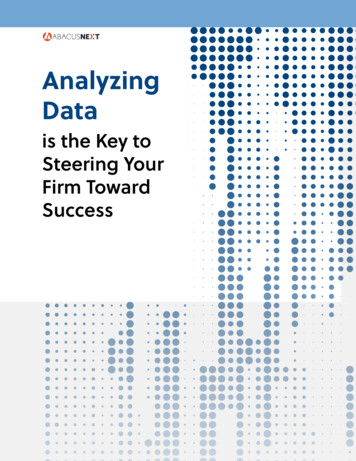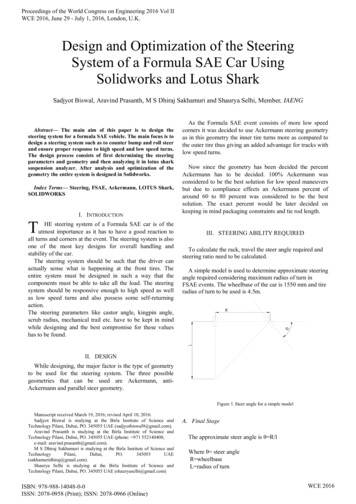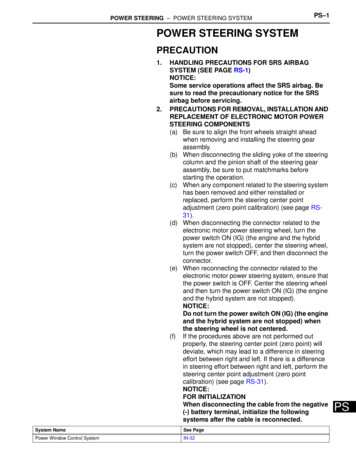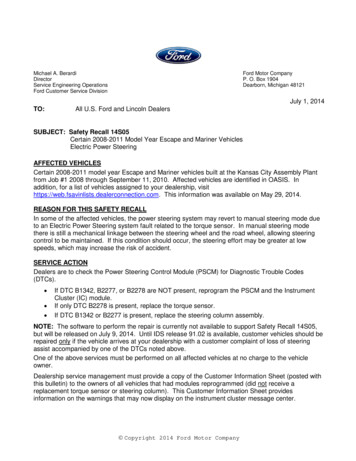
Transcription
AnalyzingDatais the Key toSteering YourFirm TowardSuccess
Studying data is even more crucial in the post-COVID era as many lawyers andemployees continue to work from home. Data analytics can help your firm: Win new business through more targeted business development efforts. Manage resources and costs more effectively. Increase employee and lawyer productivity rates. Foster more profitability.Through data analytics, firm leaders gain enhanced visibility into operationsusing objective data that identifies trends related to service areas, clientsand cases. Analyzing firm data also leads to competitive advantages thatempower your firm to identify its best-performing areas and where it canexpand its strengths.Data-driven insights point tobetter business models for the firmPractice management software houses all your firm’s business intelligence andfinancial data. The top three most important uses of legal analytics, according tothe LexisNexis 2020 survey are: GainingcompetitiveinsightsPricingprojects orlegal matters73%68%Gainingcompetitiveintelligence forpursuing newbusiness67%2Analyzing Data is the Key to Steering Your Firm Toward SuccessLaw firms that implement data analytics can develop more targeted andin-depth strategies that foster growth and success. Some 81% of firms thatuse legal analytics say clients look upon a practice favorably, according toa 2020 survey. Among users, 90% say legal analytics makes them better lawyers,and 92% plan to increase their use over the next year.
Data analytics will allow you to find the right balance in providing clients withflexible pricing options while still protecting firm profitability. Analyzing billcollections and profitability rates can help you determine when to charge hourlybillable rates and when to offer alternative options, such as flat fees or cappedand blended rates. You’ll also be able to determine which services are mostprofitable, assess client retention rates and determine the cost of acquiring anew client to make more informed business development decisions.Analyze data to assess lawyer productivityand performance ratesIn 2020, most firms (84%) report having underperforming lawyers. In nearly aquarter of all firms, more than 10% of lawyers are considered underperformers.How can you identify which lawyers are your stars and which need help to workmore productively?84%In 2020, most firms (84%) report having underperforming lawyers 10%nearly25%In nearly a quarter of all firms, more than 10% oflawyers are considered underperformers.3Analyzing Data is the Key to Steering Your Firm Toward SuccessFor example, gross revenue is an important indicator of firm health, and youcan gain competitive insights by comparing yearly revenue amounts. Breakingdown revenue into categories, such as revenue by lawyer and by department,can reveal your top performers and which departments or lawyers need helpto improve.
Determine the profitability of each practice areaAnalyze and rank practice areas based on revenue and cost analyses. Carefulconsideration of the fees and costs billed and those collected will help you determine which practice areas generate the most profit. The insights you uncover canshine like a north star, always directing firm leaders where to concentrate theirefforts for driving more business and profitability.Another useful metric is outstanding fees by practice area. Uncollected fees can indicate clients arepushing back on invoices. You may find manualbilling practices at the root of many uncollectedfees, such as invoice rejections due to failure tocomply with outside counsel guidelines. In particularly technology-driven practice areas, sendingpaper invoices and demanding paper checks cansignificantly delay payments when clients expectelectronic billing and payment options. 81%of firms that uselegal analyticssay clients lookupon a practicefavorablyDetermine where new business originatesWhat amount and types of business are generated by direct referrals? Who’sdoing the referring?Your firm may receive referrals through word-of-mouth, the local bar association or other marketing endeavors. You want to know what works best so you candouble down on successful efforts.4Analyzing Data is the Key to Steering Your Firm Toward SuccessAttorney fees, realization and utilization rates, billable hours and leverage ratesare traditional metrics that help assess lawyer productivity and performancelevels. Using an all-in-one legal practice management software with built-inaccounting enables you to capture even more critical data. You can dig deeperand discover additional insights, such as profit-per-share of practice managed,the total profit of work originated or managed, and costs of work originatedor managed. A deeper dive into the data leads to greater transparency andinsight. Firm leaders get a more detailed and holistic view of individualattorney metrics to make more informed decisions about compensation andperformance initiatives.
Understand the efficiency of employeesand attorneys working from homeRemote work is top of mind for law firms today. Before the coronaviruspandemic, 17% of U.S. employees worked from home five days per week. Thatnumber jumped to 44% during the pandemic. In the legal industry specifically,a whopping 76% of U.S. lawyers favored the remote-work option, whereas only37% were interested in working remotely prior to the pandemic.With remote work likely becoming a permanent option for many firms, decision-makers will want to understand the costs associated with managingemployees who work from home. How do those numbers compare to managingemployees in the office? Where are employees most productive? Do billablehours increase when lawyers work remotely? Which technology tools boost efficiency rates?Analyzing data will answer these questions and more to ensure you know howbest to ensure your fee earners remain productive wherever they work.17%44%Before the coronavirus pandemic, 17% of U.S. employees worked from homefive days per week. That number jumped to 44% during the pandemic.37%76%In the legal industry specifically, a whopping 76% of U.S. lawyers favored theremote-work option, whereas only 37% were interested in working remotelyprior to the pandemic.5Analyzing Data is the Key to Steering Your Firm Toward SuccessClients are attracted to firms in other ways, as well. Does your website pull in newclients? What about hosting events and speaking at conferences? Customizingand digitizing your firm’s intake procedures allow you to track origination metricson a much larger scale more accurately. You will uncover what works best tobring in new work and what doesn’t. These are relatively simple metrics to trackthat can vastly improve your firm’s business development and marketing efforts.
Businessprofessionalsspend an average of23%of their time searchingfor informationWe all know what a hassle it is to searchthrough stacks of paper and rows ofspreadsheet data to find that number youneed. Even computerized search methods(Google-like searches within a company’ssystems) still keep business professionalsspending an average of 23% of their timesearching for information.Now, easy-to-use software dashboardsgive decision-makers real-time access tothe most recent data. You can click on ametric to quickly understand more aboutthe factors that make up a metric. Data visualization techniques, such as chartsand graphs reveal trends and outliers in an instant (goodbye spreadsheets).Readily accessible data leads to faster, more informed decisions. With practice management solutions, such as AbacusLaw, it becomes quick and easy topinpoint answers, including where to focus on cutting costs and how to increaseprofitability.Data analytics can help determinethe efficacy of your firm’s marketing effortsData analytics can help law firms track the performance of their marketingcampaigns. This might help your firm determine where to target new business opportunities, understand your firm’s market position and identify whichmarketing resources are most effective.You can automate marketing activities by scheduling the release of social mediaposts, company newsletters and interpersonal emails for a specific day and time.The firm will increase its marketing reach while your marketing specialists takeback their time to devote to other valuable growth opportunities. Allow attorneysto reclaim their time, as well, by creating marketing outreach templates for theirindividual use.Analyzing Data is the Key to Steering Your Firm Toward SuccessVisual dashboards with accessible data enable leadersto make more informed decisions faster6
Amplify your firm’s growth potentialAre you ready to make more informed, data-driven decisions about your firm’sgrowth? AbacusNext offers data analytics support for law firms of all sizes —no specialists required. Learn more about data analytics for your firm.Organizations seeking growth rely on us to navigate their evolutionto a digital future — practice management, payment processing,and document automation to solve operational challenges with aneasy-to-use interface and state-of-the-art security.Ready to transform your legal practice?Learn more about strengthening your firm’s efficiency in buildinga better practice.CONTACT nalyzing Data is the Key to Steering Your Firm Toward SuccessData analytics provide a straightforward way to identify patterns and trendsthat pinpoint when and where growth occurs in your firm and where concentrated efforts will optimize additional potential. Deeper insights make it easier toincrease profitability, lower costs and win more clients through targeted businessdevelopment efforts. By investing in data analytics, your firm can seize previouslyunearthed opportunities and amplify its growth potential.7
and cases. Analyzing firm data also leads to competitive advantages that empower your firm to identify its best-performing areas and where it can expand its strengths. Data-driven insights point to better business models for the firm Practice management software houses all your firm's business intelligence and financial data.











